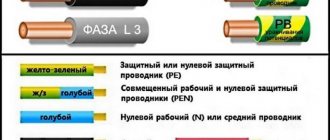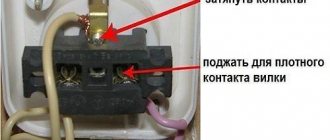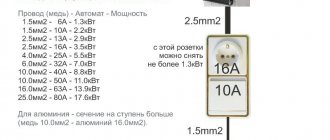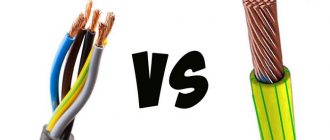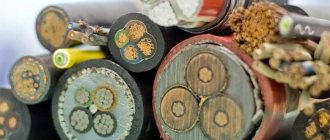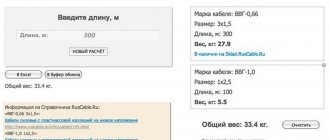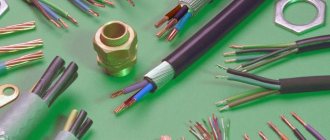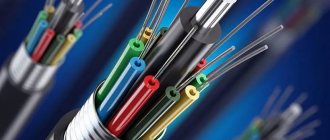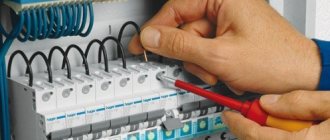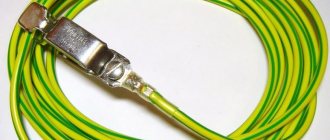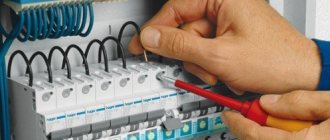What cable should I use to enter the apartment?
The apartments use input cables of the following sections:
- For a single-phase network: Copper cable (for example, VVGng-lS) 3 x 10 mm.sq. [...
- For a three-phase network: Copper cable (for example, VVGng-lS) 5 x 4 mm2. [...
- For single-phase connection – 3 x 6 mm.sq.
- For three-phase connection – 5 x 2.5 mm.sq.
Interesting materials:
How to remove hair dye from a table? How to remove paint from a bolognese jacket? How to remove paint from trousers at home? How to remove paint from trousers? How to remove dye from eyebrows? How to remove paint from a wooden door? How to remove paint from a wooden surface? How to remove dye from jeans at home? How to remove dye from jeans? How to remove dye from jeans at home?
Features of connecting the refrigerator to the electrical network
The refrigerator, unlike other household appliances such as a TV, microwave oven or light bulb, has a peculiarity - when turned on for 1-2 seconds, it consumes the so-called starting current, which is a characteristic feature of any electric motor. The magnitude of this current depends on various reasons and exceeds normal consumption by 5-8 times. Therefore, it is undesirable to connect other consumers, primarily lighting, through one long cable along with the refrigerator. When the engine starts, the voltage may drop so much that it will affect the brightness of the lamps - there will be a short-term decrease.
attention:
You need to know that in some cables the conductor intended for grounding has a smaller cross-section. Most often, its insulation is colored yellow and green.
Selection of wire (cable) cross-section - by current, power and length: table
You are faced with the question of choosing a wire (cable).
It doesn’t matter what you choose it for, for an apartment, house, garage, cottage, or for connecting an electric motor, heating device, compressor, electric lamp or any other electrical device, you still need to calculate the cross-section of the conductor that will be used for connection. Why is the calculation needed? To put it in simple words, any electrical device (equipment) or room has a current consumption, a load. In order for this wire (cable) to withstand the load consumed by the electricity consumer, a calculation is needed.
Naturally, the calculation is carried out after collecting data about the consumer, that is, it is necessary to calculate the load for each electricity consumer separately and the total load, if required.
But first you need to know how the wire cross-section is determined. The calculation is carried out according to the formula:
S = πD² ⁄ 4 = 0.785 D²
where: S – wire cross-section; π – 3.14; D – wire diameter.
The diameter of the wire can be easily measured using a caliper or micrometer. If the wire core is multi-wire, then you need to measure one wire, make a calculation and multiply by their number. The cross section of the conductor will be obtained.
Article on the topic: What is the name of a refrigerator in the ground
If you are already registered, enter your login information!
Previous article Next article
Equipment power and wire cross-section
Hello!
I have heard about some difficulties that arise when choosing equipment and connecting it (which outlet is needed for an oven, hob or washing machine). In order for you to quickly and easily solve this, as good advice, I suggest you familiarize yourself with the tables presented below.
| Types of equipment | Included | What else is needed |
| Dependent set: el. panel, oven | terminals | cable supplied from the machine, with a margin of at least 1 meter (for connection to the terminals) |
| Email panel (independent) | terminals | cable supplied from the machine, with a margin of at least 1 meter (for connection to the terminals) |
| Email oven (independent) | cable, plug may not be included | euro socket |
| Gas panel | cable and plug for electric ignition | gas hose, euro socket |
| Gas oven | cable and plug for electric ignition | gas hose, euro socket |
| Washing machine | cable, plug, hoses about 1300mm. (drain, bay) | for connection to water, ¾ outlet or straight-through tap, Euro socket |
| Dishwasher | cable, plug, hoses about 1300mm. (drain, bay) | for connection to water, ¾ outlet or straight-through tap, Euro socket |
| Refrigerator, wine cabinet | cable, plug | euro socket |
| Hood | cable, plug may not be included | corrugated pipe (at least 1 meter) or PVC box, Euro socket |
| Coffee machine, steamer, microwave oven | cable, plug | euro socket |
Electrical connection at voltage 220V/380V
| Types of equipment | Maximum power consumption | Socket | Cable cross-section | Automatic + RCD⃰ in the panel | |
| Single-phase connection | Three-phase connection | ||||
| Dependent set: el. panel, oven | about 11 kW (9) | Calculated for the power consumption of the kit | 6mm² (PVA 3*6) (32-42) | 4mm² (PVA 5*4) (25)*3 | separate at least 25A (380V only) |
| Email panel (independent) | 6-15 kW (7) | Calculated for panel power consumption | up to 9 KW/4mm² 9-11 KW/6mm² 11-15KW/10mm² (PVA 4,6,10*3) | up to 15 kW/ 4mm² (PVS 4*5) | separate at least 25A |
| Email oven (independent) | about 3.5 – 6 kW | euro socket | 2.5mm² | not less than 16A | |
| Gas panel | euro socket | 1.5mm² | 16A | ||
| Gas oven | euro socket | 1.5mm² | 16A | ||
| Washing machine | 2.5 kW | euro socket | 2.5mm² | separate at least 16A | |
| Dishwasher | 2 kW | euro socket | 2.5mm² | separate at least 16A | |
| Refrigerator, wine cabinet | less than 1KW | euro socket | 1.5mm² | 16A | |
| Hood | less than 1KW | euro socket | 1.5mm² | 16A | |
| Coffee machine, steamer | up to 2 kW | euro socket | 1.5mm² | 16A | |
⃰ Residual current device
Electrical connection at voltage 220V/380V
| Types of equipment | Maximum power consumption | Socket | Cable cross-section | Automatic + RCD⃰ in the panel | |
| Single-phase connection | Three-phase connection | ||||
| Dependent set: el. panel, oven | about 9.5KW | Calculated for the power consumption of the kit | 6mm² (PVA 3*3-4) (32-42) | 4mm² (PVA 5*2.5-3) (25)*3 | separate at least 25A (380V only) |
| Email panel (independent) | 7-8 kW (7) | Calculated for panel power consumption | up to 8 kW/3.5-4mm² (PVS 3*3-4) | up to 15 kW/ 4mm² (PVS 5*2-2.5) | separate at least 25A |
| Email oven (independent) | about 2-3 kW | euro socket | 2-2.5mm² | not less than 16A | |
| Gas panel | euro socket | 0.75-1.5mm² | 16A | ||
| Gas oven | euro socket | 0.75-1.5mm² | 16A | ||
| Washing machine | 2.5-7(with drying) kW | euro socket | 1.5-2.5mm²(3-4mm²) | separate at least 16A-(32) | |
| Dishwasher | 2 kW | euro socket | 1.5-2.5mm² | separate at least 10-16A | |
| Refrigerator, wine cabinet | less than 1KW | euro socket | 1.5mm² | 16A | |
| Hood | less than 1KW | euro socket | 0.75-1.5mm² | 6-16A | |
| Coffee machine, steamer | up to 2 kW | euro socket | 1.5-2.5mm² | 16A | |
When choosing a wire, first of all you should pay attention to the rated voltage, which should not be less than in the network. Secondly, you should pay attention to the material of the cores. Copper wire has greater flexibility than aluminum wire and can be soldered. Aluminum wires must not be laid over combustible materials.
You should also pay attention to the cross-section of the conductors, which must correspond to the load in amperes. You can determine the current in amperes by dividing the power (in watts) of all connected devices by the voltage in the network. For example, the power of all devices is 4.5 kW, voltage 220 V, which is 24.5 amperes. Use the table to find the required cable cross-section. This will be a copper wire with a cross-section of 2 mm2 or an aluminum wire with a cross-section of 3 mm2. When choosing a wire of the cross-section you need, consider whether it will be easy to connect to electrical devices. The wire insulation must correspond to the installation conditions.
| Laid open | ||||||
| S | Copper conductors | Aluminum conductors | ||||
| mm2 | Current | Power, kWt | Current | Power, kWt | ||
| A | 220 V | 380 V | A | 220 V | 380 V | |
| 0,5 | 11 | 2,4 | ||||
| 0,75 | 15 | 3,3 | ||||
| 1 | 17 | 3,7 | 6,4 | |||
| 1,5 | 23 | 5 | 8,7 | |||
| 2 | 26 | 5,7 | 9,8 | 21 | 4,6 | 7,9 |
| 2,5 | 30 | 6,6 | 11 | 24 | 5,2 | 9,1 |
| 4 | 41 | 9 | 15 | 32 | 7 | 12 |
| 6 | 50 | 11 | 19 | 39 | 8,5 | 14 |
| 10 | 80 | 17 | 30 | 60 | 13 | 22 |
| 16 | 100 | 22 | 38 | 75 | 16 | 28 |
| 25 | 140 | 30 | 53 | 105 | 23 | 39 |
| 35 | 170 | 37 | 64 | 130 | 28 | 49 |
| Installed in a pipe | ||||||
| S | Copper conductors | Aluminum conductors | ||||
| mm2 | Current | Power, kWt | Current | Power, kWt | ||
| A | 220 V | 380 V | A | 220 V | 380 V | |
| 0,5 | ||||||
| 0,75 | ||||||
| 1 | 14 | 3 | 5,3 | |||
| 1,5 | 15 | 3,3 | 5,7 | |||
| 2 | 19 | 4,1 | 7,2 | 14 | 3 | 5,3 |
| 2,5 | 21 | 4,6 | 7,9 | 16 | 3,5 | 6 |
| 4 | 27 | 5,9 | 10 | 21 | 4,6 | 7,9 |
| 6 | 34 | 7,4 | 12 | 26 | 5,7 | 9,8 |
| 10 | 50 | 11 | 19 | 38 | 8,3 | 14 |
| 16 | 80 | 17 | 30 | 55 | 12 | 20 |
| 25 | 100 | 22 | 38 | 65 | 14 | 24 |
| 35 | 135 | 29 | 51 | 75 | 16 | 28 |
Wire markings.
The 1st letter characterizes the material of the conductor: aluminum - A, copper - the letter is omitted.
The 2nd letter means: P - wire.
The 3rd letter indicates the insulation material: B - polyvinyl chloride plastic compound shell, P - polyethylene shell, P - rubber shell, N - nairite shell. The brands of wires and cords may also contain letters that characterize other structural elements: O - braid, T - for installation in pipes, P - flat, F - folded metal sheath, G - increased flexibility, I - increased protective properties, P - braid made of cotton yarn, impregnated with an anti-rot compound, etc. For example: PV - copper wire with polyvinyl chloride insulation.
PV
Installation wires PV-1, PV-3, PV-4 are intended for supplying power to electrical devices and equipment, as well as for stationary installation of lighting electrical networks. PV-1 is produced with a single-wire conductive copper conductor, PV-3, PV-4 - with twisted conductors of copper wire. The wire cross-section is 0.5-10 mm2. The wires have painted PVC insulation. They are used in alternating current circuits with a rated voltage of no more than 450 V with a frequency of 400 Hz and in direct current circuits with voltages up to 1000 V. The operating temperature is limited to the range -50…+70 °C.
PVS
The PVS installation wire is intended for connecting electrical appliances and equipment. The number of cores can be 2, 3, 4 or 5. The conductive core made of soft copper wire has a cross-section of 0.75-2.5 mm2. Available with twisted conductors in PVC insulation and the same sheath.
It is used in electrical networks with a rated voltage not exceeding 380 V. The wire is designed for a maximum voltage of 4000 V, with a frequency of 50 Hz, applied for 1 minute. Operating temperature - in the range -40...+70 °C.
PUNP
The PUNP installation wire is intended for laying stationary lighting networks. The number of cores can be 2.3 or 4. The cores have a cross-section of 1.0-6.0 mm2. The conductor is made of soft copper wire and has plastic insulation in a PVC sheath. It is used in electrical networks with a rated voltage of no more than 250 V with a frequency of 50 Hz. The wire is rated for a maximum voltage of 1500 V at a frequency of 50 Hz for 1 minute.
VVG
Power cables of the VVG and VVGng brands are designed for transmitting electrical energy in stationary alternating current installations. The cores are made of soft copper wire. The number of cores can be 1-4. Cross-section of current-carrying conductors: 1.5-35.0 mm2. The cables are produced with an insulating sheath made of polyvinyl chloride (PVC) plastic. VVGng cables have reduced flammability. Used with a rated voltage of no more than 660 V and a frequency of 50 Hz.
NYM brand power cable is designed for industrial and domestic stationary installation indoors and outdoors. The cable wires have a single-wire copper core with a cross-section of 1.5-4.0 mm2, insulated with PVC plastic. The outer shell, which does not support combustion, is also made of light gray PVC plastic.
This seems to be the main thing that it is advisable to understand when choosing equipment and wires for them))
Previous article Next article
Open and closed wiring
As we all know, when current passes through a conductor, it heats up. The higher the current, the more heat generated. But, when the same current passes through conductors with different cross-sections, the amount of heat generated changes: the smaller the cross-section, the more heat is released.
Article on the topic: How to store horseradish in the refrigerator
In this regard, when the conductors are laid open, its cross-section may be smaller - it cools down faster, since heat is transferred to the air. In this case, the conductor cools down faster and the insulation does not deteriorate. When the gasket is closed, the situation is worse - heat is removed more slowly. Therefore, for closed installations - in cable ducts, pipes, in the wall - it is recommended to take a cable with a larger cross-section.
The choice of cable cross-section, taking into account the type of installation, can also be made using the table. The principle was described before, nothing changes. There's just one more factor to consider.
Selection of cable cross-section depending on power and type of installation
And finally, some practical advice. When going to the market to buy a cable, take a caliper with you. Too often the stated cross-section does not coincide with reality. The difference can be 30-40%, which is a lot. What does this mean for you? Burnout of wiring with all the ensuing consequences. Therefore, it is better to check right on the spot whether a given cable actually has the required core cross-section (the diameters and corresponding cable cross-sections are in the table above). more about determining the cable cross-section by its diameter here .
We count: 20 x 0.8 = 16 (kW)
To make a choice of cable cross-section based on power, look at our tables:
For a three-phase 380 Volt circuit it will look like this:
As you can see, it's not difficult. I would also like to add that I advise you to choose a cable or wire with the largest cross-section of cores, in case you want to connect something else .
Related posts:
- When Power Engineer's Day in Russia in 2012 was special.
- If you are planning to study to become an electrician, I recommend reading where to study and how to get an electrician diploma
- Electrical personnel, groups
- Electrician profession, prospects
Useful advice: if you suddenly find yourself in an unfamiliar area at night. Don't use your cell phone to light your way
That's all for me, now you know how to select the cable cross-section according to power. Feel free to share with your friends on social networks.
Do-it-yourself breakdowns and repairs of two-chamber LG refrigerators
According to the rules for the operation of electrical appliances, you cannot use a carrier to connect them to the electrical network. But if there is no other choice, it is important to purchase an extension cord, taking into account the following parameters:
- The highest load, measured in Watts, that the cable can withstand.
- Length of cable.
- Presence of a grounding contact.
- Number of sockets.
Extension cords and surge protectors
Typical malfunctions of LG two-chamber refrigerators
LG refrigerators last a long time. However, technology tends to break down over time. From the first day of operation, you need to take care of the electronic control unit and the compressor, especially the inverter one. Electronic program setup requires attention. Step-by-step instructions are presented in the corresponding section of the documentation for the device.
Some models are noted in reviews as being excessively noisy. Part of the reason lies in the quality of assembly at sites scattered around the world. However, correct leveling, tightening fasteners with your own hands, and standard ventilation gaps will partially eliminate the noise of the LG refrigerator. Repair is required when extraneous knocking, whistling or strong heating of the compressor is added to the noise.
A breakdown is considered if one of the refrigerator chambers no longer maintains the set mode. There is ice in the freezer or sub-zero temperatures are observed in a cold cabinet. There may be several reasons:
- failures in the automatic control system;
- failure of temperature sensors;
- relays are faulty;
- cooling circuit problem associated with freon leak or compressor failure;
- malfunction of the magnetic valve in a single-compressor two-chamber device.
A malfunction of the No Frost system of an LG refrigerator will indicate a violation of the temperature regime, icing inside the cooling chamber. The air cooling system for products is complex and balanced. The complex includes an evaporator, from which cold air is blown by a fan into the freezer. Then the gas is supplied through the air valve to heat the positive chamber. Problems may be related to:
- the temperature sensor in the evaporator or chambers has failed;
- the fan stopped working due to icing or motor failure;
- The heating element does not work;
- The air valve is not adjusted.
The appearance of ice in the freezer or “fur coat” in the refrigerator indicates a possible malfunction in the condensate drainage circuit.
Power and length
One of the main criteria for choosing an electric carrier is the power of the product. That is, an indicator indicating the maximum permissible load that a given cable can withstand.
To connect a refrigerator, a medium-power extension cord rated at 2200 W is quite suitable. As for the cable length, it should be optimal, covering the distance from the outlet to the installation location of the refrigerator.
If you purchase a longer carrier, the wires will interfere with normal use of the kitchen. Carrying it too short will prevent you from turning on the device.
Turning on the extension cord
What wire cross-section is needed for a refrigerator?
When renovating a kitchen, to calculate the cross-section of the electrical cable for the kitchen wiring, you need to understand what household appliances will be used in the kitchen.
To calculate the cable cross-section, you need to know the power consumption of the household appliances used.
Below are three tables, one of which is a table of the power of household appliances, averaged, but accurate enough to calculate the cross-section of the electrical cable when renovating a kitchen.
Two other tables allow you to calculate the cross-section of the cable cores needed to power these devices based on the total power of household appliances.
Grounding
The presence of a grounding contact will protect users from accidental contact with high voltage in the electrical network. But not every apartment has a three-wire wiring. If the premises are being renovated, it is recommended to replace outdated wires with modern, three-core ones. But if this is not possible, you will have to connect the refrigerator to the existing network.
Refrigerator in the interior
Popular models and brands
Note! The domestic market of household appliances offers a wide range of refrigerators and brands of manufacturers to suit every taste and budget.
Among the variety of devices, experts selected the best models, examined their technical characteristics in detail and compared all the advantages of the best-selling devices and offered a list of the best and most reliable devices.
The best models in terms of price, quality, reliability
TOP 5 best models today in terms of price, quality and reliability.
Indesit DF 5200 W
A successful model with high functionality, attractive appearance and an affordable price.
A two-chamber device belonging to energy consumption class A, characterized by a convenient arrangement of cameras.
The equipment has a simple and laconic design, instantly cools a large number of products and has a long warranty period.
The unit operates in an innovative total no frost system - it prevents the formation of ice on the inner walls of the chamber and eliminates the need for the user to defrost the device.
Power of household appliances
Power of home electrical appliances:
- The hob usually has a power in the range of 6-8 kW. If you choose a more powerful hob, you will have to connect it to three phases at once.
- The stove with oven has a power of 10 kW and is connected to a three-phase network.
- An apartment boiler has a power of 1.5 to 2 kW. Homes sometimes install a stationary model of higher power.
- The heating boiler has a power of 8 to 12 kW and higher.
- A standard kitchen electric oven has a power of 3.5-4 kW.
- Household air conditioners have a power of no more than 2.4 kW.
Surge filter for a refrigerator: how to choose whether it can be connected, whether it is needed or not
When renovating a kitchen, to calculate the cross-section of the electrical cable for the kitchen wiring, you need to understand what household appliances will be used in the kitchen.
To calculate the cable cross-section, you need to know the power consumption of the household appliances used.
Below are three tables, one of which is a table of the power of household appliances, averaged, but accurate enough to calculate the cross-section of the electrical cable when renovating a kitchen.
Two other tables allow you to calculate the cross-section of the cable cores needed to power these devices based on the total power of household appliances.
